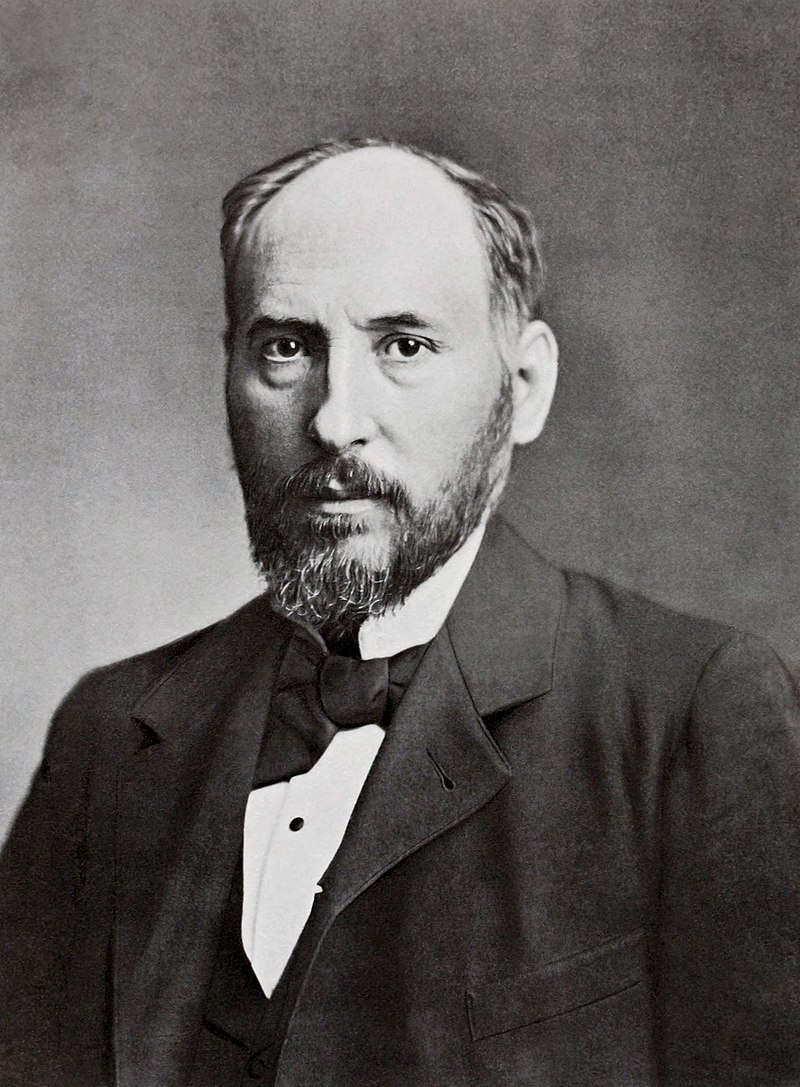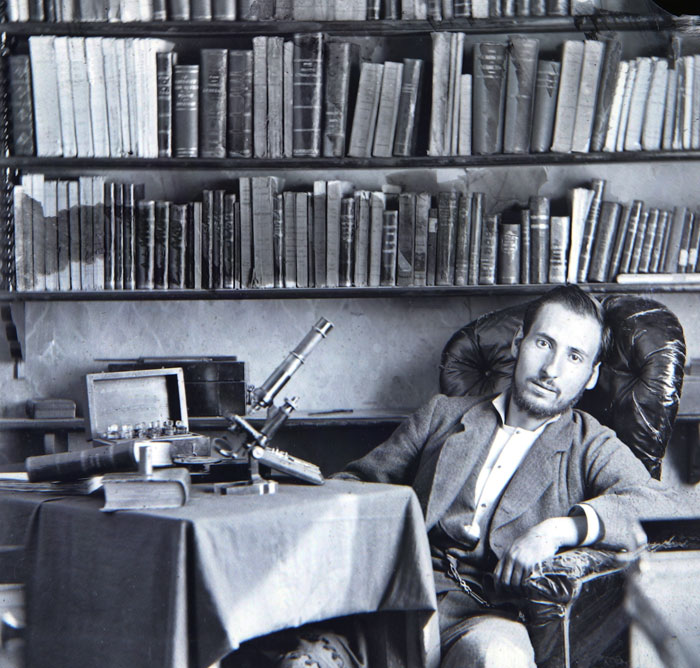Santiago Ramón y Cajal
 (1 May 1852 – 17 October 1934) was a Spanish neuroscientist, pathologist, and histologist specializing in neuroanatomy and the central nervous system. He and Camillo Golgi received the Nobel Prize in Physiology or Medicine in 1906. Ramón y Cajal was the first person of Spanish origin to win a scientific Nobel Prize. His original investigations of the microscopic structure of the brain made him a pioneer of modern neuroscience.
(1 May 1852 – 17 October 1934) was a Spanish neuroscientist, pathologist, and histologist specializing in neuroanatomy and the central nervous system. He and Camillo Golgi received the Nobel Prize in Physiology or Medicine in 1906. Ramón y Cajal was the first person of Spanish origin to win a scientific Nobel Prize. His original investigations of the microscopic structure of the brain made him a pioneer of modern neuroscience.
Hundreds of his drawings illustrating the arborizations ("tree growing") of brain cells are still in use, since the mid-20th century, for educational and training purposes.
Biography
Santiago Ramón y Cajal was born 1 May 1852 in the town of Petilla de Aragón, Navarre, Spain. As a child he was transferred many times from one school to another because of behaviour that was declared poor, rebellious, and showing an anti-authoritarian attitude. An extreme example of his precociousness and rebelliousness at the age of eleven is his 1863 imprisonment for destroying his neighbour's yard gate with a homemade cannon. He was a keen painter, artist, and gymnast, but his father neither appreciated nor encouraged these abilities, even though these artistic talents would contribute to his success later in life. His father apprenticed him to a shoemaker and barber, to "try and give his son much-needed discipline and stability."
Over the summer of 1868, his father took him to graveyards to find human remains for anatomical study. Early sketches of bones moved him to pursue medical studies. Ramón y Cajal attended the medical school of the University of Zaragoza, where his father worked as an anatomy teacher. He graduated in 1873, aged 21, and then served as a medical officer in the Spanish Army. He took part in an expedition to Cuba in 1874–75, where he contracted malaria and tuberculosis. To aid his recovery, Ramón y Cajal spent time in the spa-town Panticosa in the Pyrenees mountain range.
 After returning to Spain, he received his doctorate in medicine in Madrid in 1877. Two years later, he became the director of the Zaragoza Museum, and he married Silveria Fañanás García, with whom he had seven daughters and five sons. Ramón y Cajal worked at the University of Zaragoza until 1883, when he was awarded the position of anatomy professor of the University of Valencia. His early work at these two universities focused on the pathology of inflammation, the microbiology of cholera, and the structure of epithelial cells and tissues.
After returning to Spain, he received his doctorate in medicine in Madrid in 1877. Two years later, he became the director of the Zaragoza Museum, and he married Silveria Fañanás García, with whom he had seven daughters and five sons. Ramón y Cajal worked at the University of Zaragoza until 1883, when he was awarded the position of anatomy professor of the University of Valencia. His early work at these two universities focused on the pathology of inflammation, the microbiology of cholera, and the structure of epithelial cells and tissues.
In 1887 Ramón y Cajal moved to Barcelona for a professorship. There he first learned about Golgi's method, a cell staining method which uses potassium dichromate and silver nitrate to (randomly) stain a few neurons a dark black colour, while leaving the surrounding cells transparent. This method, which he improved, was central to his work, allowing him to turn his attention to the central nervous system (brain and spinal cord), in which neurons are so densely intertwined that standard microscopic inspection would be nearly impossible. During this period he made extensive detailed drawings of neural material, covering many species and most major regions of the brain.
In 1892, he became professor at Madrid. In 1899 he became director of the Instituto Nacional de Higiene – translated as National Institute of Hygiene , and in 1922 founder of the Laboratorio de Investigaciones Biológicas – translated as the Laboratory of Biological Investigations , later renamed to the Instituto Cajal, or Cajal Institute.
He died in Madrid on October 17, 1934, at the age of 82, continuing to work even on his deathbed.
Political and religious views
In 1877, the 25-year-old Ramón y Cajal joined a Masonic lodge. John Brande Trend wrote in 1965 that Ramón y Cajal "was a liberal in politics, an evolutionist in philosophy, an agnostic in religion".
Nonetheless, Ramón y Cajal used the term soul "without any shame".He was said to later have regretted having left organized religion, Ultimately, he became convinced of a belief in God as a creator, as stated during his first lecture before the Spanish Royal Academy of Sciences.
Discoveries and theories
Ramón y Cajal made several major contributions to neuroanatomy. He discovered the axonal growth cone, and demonstrated experimentally that the relationship between nerve cells was not continuous, or a single system as per then extant reticular theory, but rather contiguous; there were gaps between neurons. This provided definitive evidence for what Heinrich Waldeyer would name "neuron theory", now widely considered the foundation of modern neuroscience. He is also considered by some to be the first "neuroscientist" since in 1894 he stated to the Royal Society of London: “The ability of neurons to grow in an adult and their power to create new connections can explain learning.” This statement is considered to be the origin of the synaptic theory of memory.
He was an advocate of the existence of dendritic spines, although he did not recognize them as the site of contact from presynaptic cells. He was a proponent of polarization of nerve cell function and his student, Rafael Lorente de Nó, would continue this study of input-output systems into cable theory and some of the earliest circuit analysis of neural structures.
By producing excellent depictions of neural structures and their connectivity and providing detailed descriptions of cell types he discovered a new type of cell, which was subsequently named after him, the interstitial cell of Cajal (ICC). This cell is found interleaved among neurons embedded within the smooth muscles lining the gut, serving as the generator and pacemaker of the slow waves of contraction which move material along the gastrointestinal tract, mediating neurotransmission from motor neurons to smooth muscle cells.
In his 1894 Croonian Lecture, Ramón y Cajal suggested (in an extended metaphor) that cortical pyramidal cells may become more elaborate with time, as a tree grows and extends its branches.
He devoted a considerable amount of time studying French which he used to help his wife during labour and parapsychological phenomena. A book he had written on these topics was lost during the Spanish Civil War.
Distinctions
Nobel certificate awarded to the Spanish scientist Santiago Ramón y Cajal in 1906, exhibited at the Museo Nacional de Ciencias Naturales in Madrid.
Ramón y Cajal received many prizes, distinctions, and societal memberships during his scientific career, including honorary doctorates in medicine from Cambridge University and Würzburg University and an honorary doctorate in philosophy from Clark University. The most famous distinction he was awarded was the Nobel Prize in Physiology or Medicine in 1906, together with the Italian scientist Camillo Golgi "in recognition of their work on the structure of the nervous system". This caused some controversy because Golgi, a staunch supporter of reticular theory, disagreed with Ramón y Cajal in his view of the neuron doctrine. Even before Ramón y Cajal's work, Norwegian scientist Fridtjof Nansen established the contiguous nature of nerve cells in his study of certain marine life, which Ramón y Cajal failed to cite.

